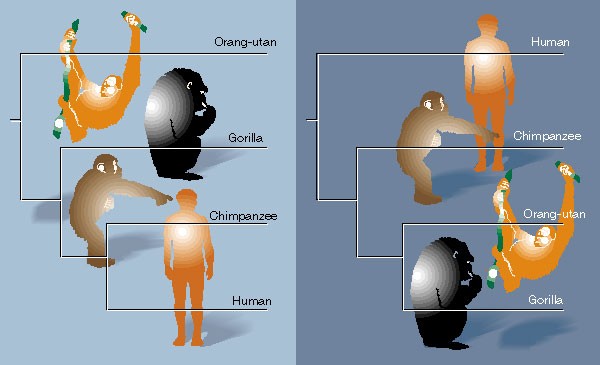Bones, molecules…or both? (original) (raw)
Evolutionary trees constructed by studying biological molecules often don't resemble those drawn up from morphology. Can the two ever be reconciled, asks Trisha Gura
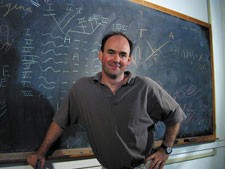
Wheeler: if you analyse enough data of many types, convergent evolution should be less of a problem.
When biologists talk of the ‘evolution wars’, they usually mean the ongoing battle for supremacy in American schoolrooms between Darwinists and their creationist opponents. But the phrase could also be applied to a debate that is raging within systematics. On one side stand traditionalists who have built evolutionary trees from decades of work on species' morphological characteristics. On the other lie molecular systematists, who are convinced that comparisons of DNA and other biological molecules are the best way to unravel the secrets of evolutionary history.
Many systematists find themselves somewhere in between these two extremes, accepting that both types of data have their strengths. And lately, some of these moderates have adopted an approach dubbed ‘total evidence’, in the hope of constructing trees, or phylogenies, to which everyone can subscribe. Rather than considering molecular and morphological evidence separately, total evidence combines both types of data in the same computer analysis. So far, the approach has relatively few converts. Many systematists argue that such disparate types of data cannot readily be combined — and even those who back total evidence disagree over how to analyse the data to avoid one type of evidence dominating the analysis. But if the schism that divides systematics is ever to be bridged, say the adherents of total evidence, achieving some sort of synthesis of molecules and morphology is essential. “We have to come up with techniques that integrate all sorts of molecular and morphological information,” argues Ward Wheeler, curator of invertebrates at the American Museum of Natural History in New York.
The whales' tale
Battles between molecules and morphology are being fought across the entire tree of life. Perhaps the most intense are in vertebrate systematics, where molecular biologists are challenging a tradition that relies on studies of fossil skeletons and the bones and soft tissue of living species. Take the debate over the origin of whales: systematists have long classified even-toed hoofed mammals, called artiodactyls, as a group, or ‘clade’, that could be further broken into four extant subclades — camels and llamas; cattle and deer; pigs and peccaries; and hippopotamuses. Modern cetaceans — whales, dolphins and porpoises — don't have toes but early fossil whales did have even-numbered appendages. The teeth of ancient cetaceans look almost identical to those from an extinct group called the mesonychids. So morphologists have classified the cetaceans and mesonychids together as a sister group to the Artiodactyla.
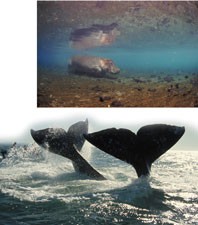
Making a splash: molecular analyses shook up evolutionary trees derived from morphology by suggesting that hippos' closest relatives are whales. Credit: PETER SCOONES/BBC WILD/GEORGE LEPP/CORBIS
But that view came under fire when molecular evidence entered the arena. The first paper to challenge tradition came from Dan Graur and Desmond Higgins at Tel Aviv University in Israel1. As in many studies of molecular evolution, they focused on the DNA carried in cellular organelles called mitochondria, which placed cetaceans in the middle of the Artiodactyla. Other teams, studying a range of different genes and proteins, singled out hippos as more closely related to whales than to any other artiodactyl, be it a cow, camel or pig2,3,4,5. “Genes doing very different things are all saying the same thing,” says John Gatesy, now at the University of Wyoming in Laramie, who was in the vanguard of this molecular assault on taxonomic orthodoxy.
Then came what Graur describes as a “magic bullet”: molecular markers that, once present, appear to act as one-way ‘signposts’ of evolutionary ancestry. In 1997, Norihiro Okada's group at the Tokyo Institute of Technology studied two families of a particular class of retrotransposon — a type of ‘jumping gene’ — called short interspersed elements (SINEs). These sequences have inserted themselves permanently into random spots in the genome of various mammals and been passed down the generations. After comparing the SINEs found at seven locations in the genome for artiodactyls and whales, the Japanese researchers again concluded that hippos are more like whales than other members of the Artiodactyla6. In August 1999, they added further evidence by analysing ten additional genomic locations for the insertion of SINEs and another type of transposon called long interspersed repeats (LINEs)7.
Redrawing this branch of the mammalian evolutionary tree according to the molecular data does more than remove hippos from their traditional position, however — it suggests that the Artiodactyla, as currently defined, is not a natural taxonomic group. “The molecular data say that artiodactyls, as traditionally recognized, go into the wastebasket,” says Zhexi Lou, a palaeontologist at the Carnegie Museum of Natural History in Pittsburgh, who recently reviewed the morphological and molecular evidence in Nature 8. “The whole picture of how we reconstruct the steps of evolution would change,” adds Maureen O'Leary, a palaeontologist at the State University of New York in Stony Brook. “We might be able to say that carnivorous whales were derived from some fully herbivorous animal like ancient hippos.”
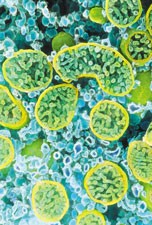
Mitochondria: does their DNA link us to Eve? Credit: SCIENCE PHOTO LIBRARY
Not surprisingly, many researchers — O'Leary included — are reluctant to simply discard decades of morphological work. “We just don't know enough yet to determine who is right,” says Hans Thewissen, a palaeontologist and anatomist at Northeastern Universities College of Medicine in Rootstown, Ohio. He believes the answer may have to await further fossil discoveries. “From the morphological side we need to be smarter about how we pick the animals we analyse and go out and get better fossils.”
If molecular data have provoked strong reactions among researchers interested in the evolution of whales, that is nothing compared to the hornet's nest stirred up among palaeoanthropologists. The arguments erupted in 1987, when Rebecca Cann, Mark toneking and the late Allan Wilson of the University of California at Berkeley introduced the study of mitochondrial (mt) DNA to the field of human origins. Palaeoanthropologists had long asserted that, based on fossil records, modern humans and extinct hominids such as Neanderthals evolved from one common ancestor called Homo erectus, which lived in Africa around 2 million years ago. Also, many subscribed to the ‘multiregional’ view of modern human origins, championed by Milford Wolpoff of the University of Michigan in Ann Arbor. This argued that, when the descendants of H. erectus left Africa, they interbred with hominids in Europeand Asia — including the Neanderthals — giving rise to the ethnic variability seen in modern populations.
Debate rages on
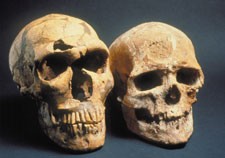
Family feud: some dispute DNA evidence that Neanderthals (left) did not breed with modern humans. Credit: SCIENCE PHOTO LIBRARY
Cann, Stoneking and Wilson's studies of mtDNA from people of African, European, Asian and Australian descent suggested otherwise. They traced all modern humans to a single female line, dubbed ‘mitochondrial Eve’, which lived in Africa 200,000 years ago, and could find no evidence of interbreeding with other hominids9. Although some of the methods and assumptions of Cann and her colleagues have since been questioned, other molecular studies have backed their broad conclusions10,11. Most recently, comparisons of modern human DNA with samples recovered from Neanderthal fossils have failed to find any evidence that modern Europeans carry Neanderthal genes12,13,14. Still the debate rages on. “We still need better methods that make fewer assumptions,” concludes Cann.
In April this year, Mark Collard at University College London and Bernard Wood at George Washington University in Washington DC published a paper that issued a broader challenge to palaeoanthropology's traditional morphological approach — which relies heavily on studies of skulls and teeth. “It struck me that after 15 to 20 years of doing morphological analysis, we hadn't validated the methods we were using,” says Wood. So the researchers constructed an evolutionary tree based on 129 skull and tooth measurements for living hominoids, including gorillas, chimpanzees, orang-utans and humans, and did the same with 62 measurements recorded on Old World monkeys, including baboons, mangabeys and macaques. They also drew upon published molecular phylogenies.

Wood: realized methods hadn't been validated. O'Leary: still has faith in morphology
At the outset, Wood and Collard assumed the molecular evidence was correct. “There were so many different lines of genetic evidence pointing in one direction,” Collard explains. But no matter how the computer analysis was run, the molecular and morphological trees could not be made to match15 (see figure, below). Collard says this casts grave doubt on the reliability of using morphological evidence to determine the fine details of evolutionary trees for higher primates. “It is saying it is positively misleading,” he says. The abstract of the pair's paper stated provocatively that “existing phylogenetic hypotheses about human evolution are unlikely to be reliable”.
Figure 1: Where do we stand?
MARK COLLARD
Where do we stand? Molecular (left) and morphological views of relationships among primates.
Many researchers dispute this conclusion, however. “You can't take some 100 arbitrary traits, plug them into a computer, and expect them to agree,” says Owen Lovejoy at Kent State University in Ohio.
So can the disparities between molecular and morphological trees ever be resolved? Some proponents of the molecular approach claim there is no need. The solution, they say, is to throw out morphology, and accept their version of the truth. “Our method provides the final conclusion about phylogeny,” claims Okada. Shared ancestry means a genetic relationship, the molecular camp argues, so it must be better to analyse DNA and the proteins it encodes, rather than morphological characters that can end up looking similar as a result of convergent evolution in unrelated groups, rather than through common descent. But morphologists respond that convergence can also happen at the molecular level, and note there is a long history of systematists making large claims based on one new form of evidence, only to be proved wrong at a later date.
Okada's studies on SINEs and LINEs, held up by the molecular enthusiasts as their strongest line of evidence, have attracted particular scrutiny. “It is an outdated method in systematics to assert that one aspect of the organism somehow dictates the true phylogeny,” says O'Leary. “Okada is approaching this completely backwards by asserting that his retrotransposons are so significant that he cannot imagine a way in which they evolved convergently.”
In a commentary published alongside the Okada team's 1999 paper, David Hillis of the University of Texas in Austin pointed out that there is another way in which the retrotransposon evidence could be flawed: regions around the SINE insertion site could mutate so much over time that the DNA elements are no longer recognizable16. That would obscure links between related groups that diverged in the distant evolutionary past, Hillis argued. “I think we have all become aware that the genetic data have their own limitations and assumptions,” says palaeoanthropologist Christopher Stringer at the Natural History Museum in London.
Lovejoy believes progress may come through the study of developmental genetics. For instance, he notes, individual members of the Hox gene family can influence the development of several bones. This means that an evolutionary shift towards shorter digits, for instance, could also lead to a shortening of limb length as a by-product, and vice versa. Without knowledge from developmental studies, says Lovejoy, morphologists can mistakenly assume they are dealing with independent characters — and so bias their analysis. “There is nothing wrong with morphology in establishing phylogeny,” he concludes, “but it has to be done very carefully with full knowledge of the functional and developmental basis of the traits you are working with.” Michael Novacek, a vertebrate palaeontologist at the American Museum of Natural History, agrees that this developmental focus provides “an excellent approach”, but adds that it is limited at present by the availability of data. “The developmental database grows very slowly,” he says.
Unorthodox experiments
For his part, Wood believes that reconciling molecules and morphology may require morphologists to look at different structures. Sally Gibbs, a PhD student in Wood's lab, has combed the literature for non-skeletal anatomical traits that could be used to distinguish five living hominoid genera. In April, at the annual meeting of the American Association of Physical Anthropologists in San Antonio, Texas, Gibbs revealed that a tree based on these characters did resemble the molecular phylogeny. “This is not molecules versus morphology,” concludes Wood. “It seems to be molecules and soft tissue versus hard tissue.”
Wood suggests that skeletal tissue may be much more plastic in response to subtle environmental and genetic changes than was previously thought — a view that finds support from unorthodox experiments by anthropologist Dan Lieberman at George Washington University. He has run pigs on treadmills and analysed their bone content and thickness. Not only did the athletic pigs' leg bones end up stronger and thicker, but so did their skulls17. “Perhaps growth hormone levels play a role,” Lieberman suggests.
But both soft tissues and molecular data have an obvious limitation: more than 85% of mammalian genera are extinct, and are usually studied from fossils in which bones and teeth are the only structures left. If systematists abandoned skeletal structures they would end up constructing phylogenies around a preponderance of missing creatures.
This is where total evidence, also known as simultaneous analysis, could come to the rescue. First employed in 1989 by Arnold Kluge at the University of Michigan in his phylogenetic studies of Epicrates, a genus of snakes in the boa family18, this approach takes both molecular and morphological data and throws them into the same computer analysis. Although the data may not be consistent, the idea is that misleading evidence will pale in significance as more and more information is added. If you compile enough data, claim the proponents of total evidence, similarities caused by convergent evolution — called homoplasies — will fall out and the evolutionary truth will eventually emerge. “We have an unflappable appetite for data,” says Wheeler, who champions the approach.
In a landmark paper, Kluge and Doug Eernisse of California State University in Fullerton demonstrated the power of the technique by applying it to the phylogeny of the amniotes19 — a group that embraces mammals and reptiles. Since then, total evidence has been applied to a range of taxa including arthropods20,21,22,23,24, crocodylians25, and primates26. It has also been used to investigate relationships between toothed and baleen whales27.
Suspicions remain
But these attempts at synthesizing molecules and morphology have not yet succeeded in closing the gulf that divides the two camps. At one extreme, molecular biologist Graur rejects any approach that offers an olive branch to the morphologists: “If something is right, why dilute it with something that is wrong?” On the other side, many morphologists remain deeply suspicious of total evidence, seeing it as a means of constructing phylogenies which pay no more than lip service to morphology. Novacek complains that molecular data, which are fast accumulating, will inevitably dominate total evidence analyses. The approach, he argues, may provide a subtle way for molecular biologists to say “Let's get around this traditionalism”.
No one has yet dared apply total evidence to human origins. But the technique has impinged upon the whale–artiodactyl story, albeit so far with inconclusive results. Last year, O'Leary and Gatesy published separate back-to-back total evidence papers examining the problem in the journal Cladistics28,29. Gatesy and his colleagues, using datasets on extant species dominated by molecular evidence, backed the whale–hippo link. O'Leary, using a greater amount of morphological data, including fossil evidence, was unable to resolve the data into a single tree. In an attempt to clarify the issue, the pair have now teamed up. Gatesy is sequencing genes from selected whales and artiodactyls, whereas O'Leary is cataloguing morphological features of the same species. They hope to resolve the whale–hippo controversy in one large-scale simultaneous analysis. “If we collect more data from either side, the two signals may come to resemble one another,” says O'Leary.
How the data will be analysed remains to be seen. O'Leary is concerned about the problem of fossils, for which there are morphological data but no molecular evidence. She still wonders if it might be best to analyse molecules and morphology separately, to see if the two trees can be made to agree.
Few systematists expect any single study to resolve so vexed a debate, particularly given the strong views on both sides. But most can agree on one thing: the battles between molecules and morphology, and the attempts at synthesizing the two, are forcing systematists to adopt more quantitative, reproducible methods. “There's no more of this ‘one skull here and one skull there’,” says Cann. “You have to have numbers that look like you can do a statistical analysis.” And that, say systematists, is transforming their discipline from a fusty biological sideshow to a vibrant, mainstream field. “There is quite a broad revolution going on as people are being forced to evaluate what they really have,” observes Collard.
